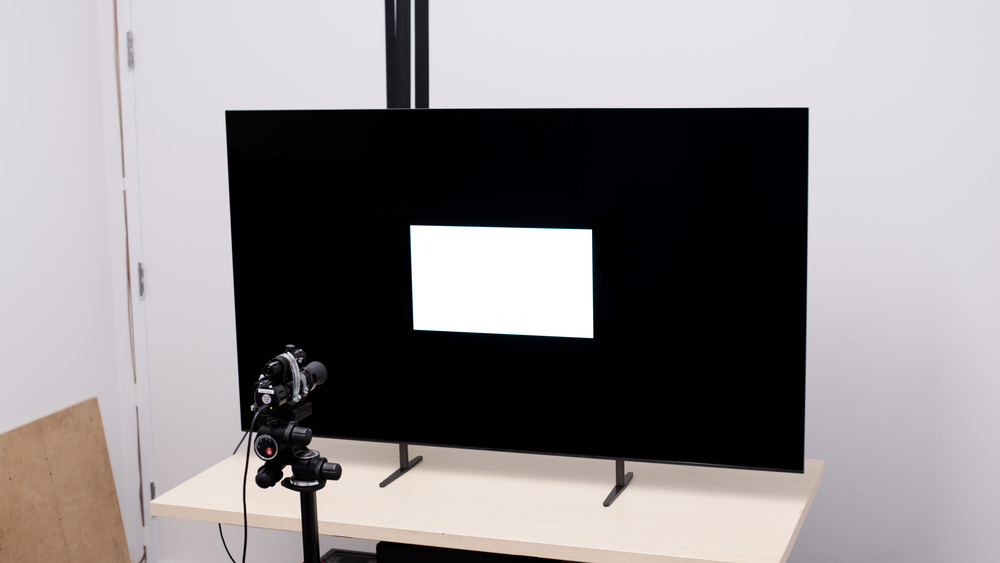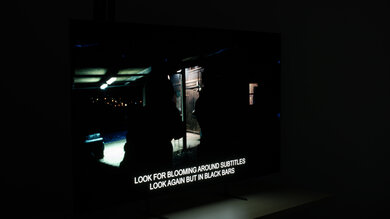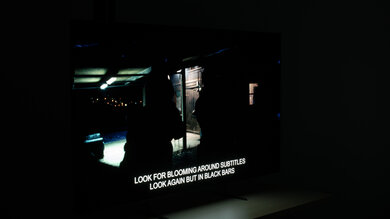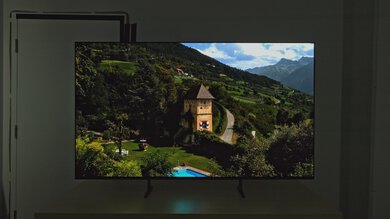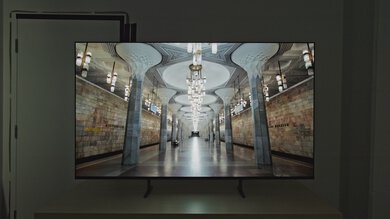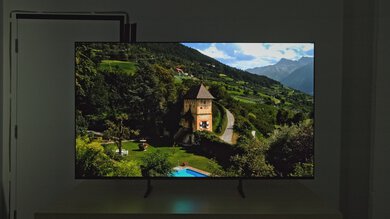The Sony BRAVIA 8 OLED is Sony's OLED option in their 2024 BRAVIA lineup and is the successor to the Sony A80L/A80CL OLED. It sits above the Sony BRAVIA 7 QLED and below the Sony BRAVIA 9 QLED. Unlike the Sony A95L OLED that's been carried over from last year, the BRAVIA 8 uses a traditional WOLED panel instead of a QD-OLED panel. The TV uses the popular Google TV interface that's packed with apps and has other smart features like voice control and the ability to cast content from your phone. It's also loaded with modern features like HDMI 2.1 bandwidth, up to 4k @ 120Hz, VRR support, and Dolby Vision HDR. The TV has a built-in 50W 2.1 channel speaker system, and you can also use the TV as a center channel with compatible Sony soundbars and receivers. We bought and tested the 65-inch model, and it's available in three sizes: 55-inch, 65-inch, and 77-inch.
Our Verdict
The Sony BRAVIA 8 is amazing for mixed usage. The TV is suitable for use in a bright room due to its very good SDR brightness and outstanding reflection handling. However, it also looks remarkable in a dark room thanks to its nearly infinite contrast ratio, with highlights that stand out in HDR content due to its good HDR brightness. It also has a wide viewing angle that makes it a fantastic choice for watching TV with a group. The TV's nearly instantaneous response time means fast motion has no noticeable blur behind it, and its advanced gaming features make it an outstanding option if you're looking for a TV to pair with modern consoles.
-
Near-infinite contrast ratio for perfect blacks with no blooming around bright highlights.
-
Very good SDR brightness and outstanding reflection handling makes it suitable for a bright room.
-
Nearly instantaneous response time for no noticeable blur behind fast motion.
-
Good HDR peak brightness that makes highlights stand out.
-
Incredibly wide viewing angle for a consistent image from the sides.
-
Only decent pre-calibration SDR accuracy.
The Sony BRAVIA 8 is excellent for watching TV shows. The built-in Google TV interface is loaded with streaming apps, making it easy to find your favorite shows. If you watch shows from low-quality and/or low-resolution streams or on DVD, this TV does an impressive job of upscaling and an excellent job at smoothing out low-quality content. It's a great option for watching shows with a group due to its wide viewing angle, and its very good SDR brightness and outstanding reflection handling means it overcomes glare in a room with the lights on.
-
Very good SDR brightness and outstanding reflection handling makes it suitable for a bright room.
-
Impressive image processing with low-quality and low-resolution content.
-
Incredibly wide viewing angle for a consistent image from the sides.
-
Only decent pre-calibration SDR accuracy.
The Sony BRAVIA 8 is amazing for watching sports. It overcomes glare thanks to its outstanding reflection handling and very good SDR brightness, so it's well-suited for a room with the lights on. It's also a great option for watching the game with your friends due to its wide viewing angle, as the image remains consistent when viewed from the sides of the screen. The TV's nearly instantaneous response time delivers fast-moving players and objects with no noticeable blur behind them, and its excellent gray uniformity means you aren't distracted by the dirty screen effect when watching sports with large areas of uniform color, like hockey.
-
Excellent gray uniformity with no noticeable dirty screen effect.
-
Very good SDR brightness and outstanding reflection handling makes it suitable for a bright room.
-
Nearly instantaneous response time for no noticeable blur behind fast motion.
-
Impressive image processing with low-quality and low-resolution content.
-
Incredibly wide viewing angle for a consistent image from the sides.
-
Only decent pre-calibration SDR accuracy.
The Sony BRAVIA 8 is outstanding for playing video games. The TV has HDMI 2.1 bandwidth on two of its ports and supports up to 4k @ 120Hz with VRR, so it's a fantastic choice to pair with modern consoles. It has very good SDR brightness and outstanding reflection handling, so you can game in a room with the lights on without being distracted by reflections on the screen. There's no noticeable blur behind fast motion due to the TV's nearly instantaneous response time, and the TV's incredibly low input lag delivers a responsive gaming experience with no noticeable delay between your controller inputs and the action on screen. You also don't have to trade in picture quality for performance since enabling Game Mode doesn't impact the image.
-
Incredibly low input lag for a very responsive experience.
-
Very good SDR brightness and outstanding reflection handling makes it suitable for a bright room.
-
Nearly instantaneous response time for no noticeable blur behind fast motion.
-
HDMI 2.1 bandwidth is limited to two ports, one of which is also the eARC port.
-
BFI feature only works at 60Hz.
The Sony BRAVIA 8 is excellent for watching movies in a dark room. The TV has remarkable contrast and incredible black uniformity, so it delivers deep, inky blacks in a dark room with no blooming when bright highlights are also on screen. Highlights stand out well in HDR content thanks to the TV's good HDR brightness, and colors are vibrant and lifelike due to its wide color gamut. It removes 24p judder from any source, so movies are judder-free no matter how you watch them. If you watch films with a low bit rate from lower-quality streams or on DVD, the TV does an excellent job at smoothing out artifacts. Unfortunately, the TV's pre-calibration SDR accuracy is only decent, so you'll need to get it calibrated if you care about an accurate image in SDR.
-
Near-infinite contrast ratio for perfect blacks with no blooming around bright highlights.
-
Removes 24p judder from any source.
-
Colors are vibrant and lifelike due to the TV's wide color gamut.
-
Good HDR peak brightness that makes highlights stand out.
-
Dolby Vision & DTS audio support.
-
Impressive image processing with low-quality and low-resolution content.
-
Aggressive ABL can be distracting with large areas of brightness.
-
Only decent pre-calibration SDR accuracy.
The Sony BRAVIA 8 is fantastic for playing video games in HDR. It displays fast motion with no noticeable blur due to its nearly instantaneous response time, and its incredibly low input lag delivers a responsive gaming experience with no noticeable delay between your controller inputs and the action on screen. Using Game Mode doesn't negatively affect image quality, so you don't have to compromise it if you want the best possible performance. The TV looks remarkable in a dark room with deep and inky blacks thanks to its nearly infinite contrast ratio, and highlights stand out in HDR games due to its good HDR brightness. It's a fantastic option to pair with modern consoles due to its HDMI 2.1 bandwidth, up to 4k @ 120Hz, and VRR support.
-
Near-infinite contrast ratio for perfect blacks with no blooming around bright highlights.
-
Incredibly low input lag for a very responsive experience.
-
Nearly instantaneous response time for no noticeable blur behind fast motion.
-
Colors are vibrant and lifelike due to the TV's wide color gamut.
-
Good HDR peak brightness that makes highlights stand out.
-
Aggressive ABL can be distracting with large areas of brightness.
-
HDMI 2.1 bandwidth is limited to two ports, one of which is also the eARC port.
-
BFI feature only works at 60Hz.
The Sony BRAVIA 8 is fantastic for use as a PC monitor. The TV has very good SDR brightness and outstanding reflection handling, so it overcomes glare in a bright room. You aren't distracted by the dirty screen effect when looking at large areas of uniform color due to its excellent uniformity, and its wide viewing angle means you can sit close to the screen, and the edges remain consistent with the center. It provides a responsive experience thanks to its incredibly low input lag, and its nearly instantaneous response time means there's no noticeable blur behind quick cursor movements or when quickly scrolling through pages. The TV properly displays chroma 4:4:4 from a PC, which is essential for clear text. Unfortunately, due to its WRGB subpixel layout, there are still minor clarity issues with text, although most people won't be bothered by it.
-
Incredibly low input lag for a very responsive experience.
-
Excellent gray uniformity with no noticeable dirty screen effect.
-
Very good SDR brightness and outstanding reflection handling makes it suitable for a bright room.
-
Nearly instantaneous response time for no noticeable blur behind fast motion.
-
Incredibly wide viewing angle for a consistent image from the sides.
-
Risk of permanent burn-in.
-
Text visibility issues due to the TV's WRGB subpixel layout.
-
HDMI 2.1 bandwidth is limited to two ports, one of which is also the eARC port.
-
BFI feature only works at 60Hz.
- 8.9 Mixed Usage
- 8.6 TV Shows
- 8.8 Sports
- 9.3 Video Games
- 8.8 HDR Movies
- 9.1 HDR Gaming
- 9.2 PC Monitor
- Updated Jun 20, 2024: Review published.
- Updated Jun 14, 2024: Early access published.
- Updated Jun 05, 2024: Our testers have started testing this product.
- Updated May 31, 2024: The product has arrived in our lab, and our testers will start evaluating it soon.
- Updated May 22, 2024: We've purchased the product and are waiting for it to arrive in our lab.
Differences Between Sizes And Variants
We bought and tested the 65-inch Sony BRAVIA 8 OLED; the results are also valid for the 55-inch and 77-inch models. Costco has a 55-inch and a 65-inch variant of the TV with different model codes. These variants perform the same, but they come with an extended warranty, an extended trial for the Sony Pictures Core streaming service, and a backlit remote.
| Size | Model | Costco Variant |
|---|---|---|
| 55" | Sony K-55XR80 | Sony K55XR80CB |
| 65" | Sony K-65XR80 | Sony K65XR80CB |
| 77" | Sony K-77XR80 | - |
Our unit was manufactured in May 2024; you can see the label here.
Compared To Other TVs
The Sony BRAVIA 8 is an amazing TV overall, but it doesn't really stand out in the crowd of OLED TVs. Unlike the top-tier Sony A95L OLED, which uses a QD-OLED panel, the BRAVIA 8 uses a traditional WOLED panel and doesn't use MLA for increased brightness like the LG G4 OLED. It's most comparable to the LG C4 OLED, but it's not as bright in HDR and doesn't support 4k @ 144Hz, and it has surprisingly worse accuracy in SDR and HDR. It's also a bit more expensive than the C4, and since the C4's image processing is pretty much on par with BRAVIA 8's, it's the better choice for almost everyone.
For more options, check out our recommendations for the best OLED TVs, the best gaming TVs, and the best TVs for watching movies.
The Sony BRAVIA 8 OLED and the LG C4 OLED are very similar TVs, but the LG is better overall. The LG gets brighter in HDR, so highlights pop out more in HDR content. The LG also has better SDR pre-calibration accuracy and PQ EOTF tracking, so it's more accurate in both SDR and HDR. Finally, the LG supports up to 4k @ 144Hz, whereas the Sony only supports up to 4k @ 120Hz, so it's a bit better for PC gamers with high-end graphics cards.
The Sony BRAVIA 8 OLED is essentially a brighter version of the Sony A80L/A80CL OLED. Both TVs are very similar, but the BRAVIA 8 gets noticeably brighter in SDR, so it overcomes more glare in a bright room. The BRAVIA 8 is also noticeably brighter in HDR when using 'Game Mode,' so you don't have to trade in brightness for the best possible performance. On top of that, the BRAVIA 8 has lower input lag for a more responsive gaming experience. On the other hand, the A80L has better SDR pre-calibration accuracy, and it tracks the PQ EOTF curve closer, so it's the more accurate TV overall.
The Sony BRAVIA 8 OLED and the Sony BRAVIA 9 QLED are better than each other in different ways. As impressive as the contrast and local dimming control on the BRAVIA 9 is, the BRAVIA 8 is an OLED, so it provides even deeper blacks with no blooming at all. The other main advantages of the BRAVIA 8's OLED panel are its nearly instantaneous response time and much wider viewing angle. However, the BRAVIA 9 has a big advantage when it comes to brightness: It is much brighter in SDR, so it overcomes glare in the brightest of rooms, and it's also much brighter in HDR, so it can take better advantage of HDR content that gets incredibly bright. On top of that, the BRAVIA 9 is more accurate in SDR and HDR.
The Sony A95L OLED is better than the Sony BRAVIA 8 OLED. The A95L uses a QD-OLED panel, displaying more vibrant, lifelike, and brighter colors in HDR with less banding. It's also brighter in HDR and has better PQ EOTF tracking, so highlights pop out more on it, and it displays an image that is closer to the content creator's intent. The A95L is brighter in SDR, too, so it overcomes a bit more glare in a bright room. The A95L also has much better SDR pre-calibration accuracy; it's so impressive that even the most astute observers won't feel the need to get it calibrated.
The LG G4 OLED is better than the Sony BRAVIA 8 OLED. If you're a PC gamer, the LG is better due to its support for up to 4k @ 144Hz. The LG is the brighter TV overall, so it overcomes more glare in a bright room when watching SDR content, and highlights pop out a lot more in HDR content. The LG is also more accurate in both SDR and HDR due to its better PQ EOTF tracking and SDR pre-calibration accuracy. Finally, as good as the viewing angle is on the Sony, the LG's is wider, so the image holds up even better when viewed from the sides of the screen.
The Samsung S90D/S90DD OLED (QD-OLED) is better than the Sony BRAVIA 8 OLED. The Samsung gets a lot brighter in HDR, so highlights pop out more in HDR content. The Samsung also displays more lifelike, more vibrant, and brighter colors than the Sony with less banding. On top of that, the Samsung is more accurate in both SDR and HDR, has an even wider viewing angle, and supports 4k @ 144Hz for PC gamers with high-end graphics cards. However, the Sony is a bit better when it comes to upscaling low-resolution content and smoothing out low-quality content.
The Sony BRAVIA 8 OLED is better than the Sony BRAVIA 7 QLED in most ways. The BRAVIA 8 has a near-infinite contrast ratio and perfect black uniformity, so it displays deeper blacks with no blooming. The BRAVIA 8 also has a wider viewing angle, making it more suitable for a wide seating arrangement. Fast motion has less blur behind it on the BRAVIA 8 due to the TV's faster response time. However, the BRAVIA 7 has better SDR pre-calibration accuracy, and it's the brighter TV overall.
Test Results
The TV uses two metal feet that you can adjust to four different positions in total. You can have the feet close together in a narrow position or further apart from each other in a wider position. On top of that, you can set the feet to a low or high position, depending on your needs. The low position lifts the TV about 1.73 inches, so it sits very close to your table. The high position (pictured above) lifts the TV about 3.86 inches, so almost any soundbar fits underneath without blocking the screen.
Footprint of the 65-inch stand in the narrow position: 22.95" x 9.84".
Footprint of the 65-inch stand in the wide position: 48.98" x 9.84".
The back of the TV is made entirely of plastic and has the familiar checkerboard pattern similar to many other recent Sony TVs. The inputs are on the far left side of the TV when facing the front, but they're in a recessed cutout, so they're a bit hard to reach if you have the TV mounted flush to the wall. There's a plastic cover that can be used to hide the inputs section, but there are no clips for cable management.
The TV is an OLED and has no backlight, so its self-lit pixels give it the same performance as a TV with perfect local dimming and no zone transitions. We still film the zone transition video on the TV, so you can see how it compares to a TV with local dimming.
The Sony BRAVIA 8 has good HDR brightness that makes highlights stand out during darker scenes. Combined with its remarkable contrast, this TV provides an impactful HDR viewing experience. Unfortunately, large bright scenes are significantly dimmer than smaller, specular highlights due to its aggressive Automatic Brightness Limiter (ABL).
These measurements are after calibrating the HDR white point with the following settings:
- HDR Picture Mode: Professional
- Brightness (HDR): Maximum
- Contrast (HDR): 90
- Color Temperature: Expert 2
- Peak Luminance: High
- HDR Tone Mapping: Gradation Preferred
Results with 'HDR Tone Mapping' set to Brightness Preferred:
- Hallway Lights: 657 cd/m²
- Yellow Skyscraper: 560 cd/m²
- Landscape Pool: 271 cd/m²
Most scenes are slightly brighter in Game Mode, but the difference is small, and it's a bit less accurate. Highlights pop out during darker moments in games, and combined with its remarkable contrast, this TV provides an impactful HDR gaming experience.
These measurements are after calibrating the HDR white point with the following settings:
- HDR Picture Mode: Game
- Brightness (HDR): Maximum
- Contrast (HDR): 90
- Color Temperature: Expert 2
- Peak Luminance: High
- HDR Tone Mapping: Off
Results with 'HDR Tone Mapping' set to Brightness Preferred:
- Hallway Lights: 537 cd/m²
- Yellow Skyscraper: 375 cd/m²
- Landscape Pool: 189 cd/m²
The Sony BRAVIA 8 has excellent PQ EOTF tracking, but a large portion of shadows and mid-tones are displayed a bit dimmer than intended, and some mid-tones and highlights are displayed a bit brighter than intended. There's a gradual roll-off near the TV's peak brightness to maintain details in highlights that are brighter than what the TV is capable of.
The Sony BRAVIA 8 has very good SDR brightness and overcomes glare in bright rooms. Its Automatic Brightness Limiter (ABL) is aggressive when bright highlights take up most of the screen or if the entire image is bright, like when watching hockey. Outside of that, there isn't much variation in the TV's SDR peak brightness.
These measurements are after calibration with the following settings:
- Picture Mode: Professional
- Brightness (SDR): Maximum
- Contrast (SDR): 90
- Gamma (SDR): 0
- Color Temperature: Expert 1
- Peak Luminance: High
The TV has an excellent color gamut. It covers nearly the entire range of colors in the DCI-P3 color space, and colors are extremely accurate. Its coverage of the Rec.2020 color space used mostly in some nature documentaries and animated films is good, but all colors are undersaturated and inaccurate, with greens and cyans faring the worst.
The TV has very good color volume. It displays dark, saturated colors very well, and its ability to display bright whites is outstanding. It doesn't display other colors as brightly as it does whites, but it's still enough to display bright and vibrant colors.
The Sony BRAVIA 8 has just decent pre-calibration accuracy. Its white balance is disappointing, with blues very overrepresented in mid-grays and brighter grays. The color temperature is noticeably cooler than our target of 6500K. The color accuracy is great, but there are still some inaccuracies with most colors. Gamma is close to our target of 2.2, but some scenes are slightly too dark, while others are slightly too bright.
The TV has fantastic accuracy after calibration. The white balance and color temperature are essentially perfect. Gamma is now closer to our target of 2.2, with only some bright scenes being slightly too bright. Color accuracy is even better than before, but there are still some minor inaccuracies with yellows, reds, light blues, and whites.
You can see our full calibration settings here.
The TV has an incredibly wide viewing angle that remains mostly consistent from almost any angle, but there is some color washout at more aggressive angles. Still, it's an excellent choice for watching TV in a group setting.
The TV has outstanding reflection handling. Its glossy screen finish significantly reduces the intensity of indirect reflections, like when you have glare from a ceiling light that isn't directly facing the screen. It does a fantastic job of reducing the intensity of direct reflections, like a lamp positioned in front of the screen.
The TV has very good HDR native gradient handling. There's some noticeable banding in dark grays and bright greens, but all other colors have minimal banding or no banding at all.
The TV does an excellent job with upscaling low-resolution content like DVDs, standard definition cable channels, and lower-resolution streams. Details are well-defined and clear enough, but very fine details and small hard-coded text are a bit hard to make out.
Sharpness processing was calibrated with no over-sharpening for low-resolution content, with the following settings:
- Sharpness: 50
- Reality Creation: Auto
The TV adds excessive sharpening when adjusting the default value of '50' to '51,' which you can see here. You can also see this unusual behavior by comparing the two photos below.
The Sony BRAVIA 8 uses a WOLED panel with a WRGB pixel structure where all four pixels are never lit at the same time. Due to its subpixel layout, it has minor issues with displaying text on Windows since ClearType isn't well optimized to non-RGB subpixel layouts, but most users won't be bothered by this.
The Sony BRAVIA 8 has a nearly instantaneous response time, resulting in incredibly clear motion with almost no blur behind fast-moving objects. Due to the sample-and-hold nature of OLED technology, there's still some persistence blur when gaming at 60Hz, but it's not noticeable at higher refresh rates.
This TV doesn't have a traditional backlight and doesn't use pulse-width modulation (PWM) to dim each pixel, but it's not completely flicker-free. There's a slight dip in brightness that corresponds to the TV's refresh rate. This differs from the PWM flicker on TVs with LED backlights and occurs on every OLED we've tested. It's not noticeable, and most people won't be bothered by this, but it can still bother people who are extra sensitive to flicker.
The TV has an optional black frame insertion (BFI) feature that reduces the appearance of persistence blur caused by the TV's nearly instantaneous response time. It can only insert black frames at a 60Hz refresh rate.
This TV has an optional motion interpolation feature to improve the clarity of motion. It does a good job at smoothing out slower scenes, but there are some noticeable artifacts present. In faster-moving scenes, it can't keep up, and there are distracting artifacts and haloing.
Unfortunately, due to the TV's nearly instantaneous pixel response time, there's stutter with low frame rate content, which is most noticeable during slow panning shots.
This TV removes judder automatically from 24p sources, like a Blu-ray player or an external streaming device with a 'Match Frame Rate' feature. For 60Hz sources, like a cable box or the native apps, Motionflow has to be enabled, with both sliders at 'Min' and CineMotion set to 'High' to remove judder.
The TV supports HDMI Forum VRR and G-SYNC but doesn't support FreeSync. It works well across a wide refresh rate range and supports sources with Low-Frame-Compensation (LFC), which ensures your games remain nearly tear-free even when your frame rate drops very low.
This TV has incredibly low input lag when set into Game Mode, which ensures a very responsive gaming experience with very little delay between your actions with your controller or mouse and the action on-screen.
Outside of game mode, the TV's input lag is much higher, and there's a noticeable delay when hitting buttons on the remote, like when pausing a movie.
The Sony BRAVIA 8 supports all common resolutions up to 4k @ 120Hz on two of its four HDMI ports. Chroma 4:4:4 signals are displayed properly with all supported resolutions when the TV's 'Content Type' is set to Game or PC, which is important for text clarity. Unfortunately, the TV doesn't support 1440p.
With the exception of 1440p, the TV is fully compatible with everything the PS5 offers, like 4k @ 120Hz, as well as HDMI Forum VRR. It also supports Auto Low Latency Mode, so you don't have to manually switch to Game Mode to get the lowest input lag.
With the exception of 1440p, the TV is fully compatible with everything the Xbox Series X|S offers, including 4k @ 120Hz, HDMI Forum VRR, FreeSync Premium Pro, and Dolby Vision gaming. It also supports Auto Low Latency Mode, so you don't have to manually switch to Game Mode to get the lowest input lag.
The Sony BRAVIA 8 has HDMI 2.1 bandwidth on HDMI ports 3 and 4, with both supporting up to 4k @ 120Hz. Unfortunately, the HDMI 3 port is also the eARC port, so you lose a high bandwidth port when you plug a soundbar into the TV. The TV supports Dolby Vision, and it has an ATSC 3.0 tuner, so you can watch 4k content over the air.
Like some previous Sony TVs, you can use the TV's built-in speakers as a center channel when paired with a soundbar or receiver. Unfortunately, it only has Sony's S-Center input and doesn't have traditional speaker inputs, so it's only compatible with certain soundbars and receivers made by Sony.
The TV supports eARC, which lets you pass high-quality, uncompressed audio to a compatible receiver or soundbar through an HDMI cable. It supports all major audio formats, so you don't have to worry about compatibility with external sources.
The Sony BRAVIA 8 has a decent frequency response. It produces some bass, but it's not enough for impactful bass. The TV's sound profile is well-balanced at moderate volume levels, making dialogue easy to understand. The sound becomes unbalanced near and at the TV's maximum volume, which is unfortunate since the TV doesn't get very loud.
The TV has good distortion performance. There's no audible distortion at moderate volume levels, and although the distortion increases a bit as you raise the volume, it's only audible at maximum volume.
The Sony BRAVIA 8 uses version 12 of the popular Google TV operating system, and the interface is smooth and easy to use. The TV has a minor bug when using the 'Detailed Signal Info' option that shows a native refresh rate of 120Hz when outputting a 60Hz signal.
The TV has a fantastic selection of apps, so finding your favorite content is easy. You can cast content from your phone using the built-in AirPlay 2 or Chromecast. You can also play videos directly from a USB stick.
The remote is backlit and has a matte finish with blue speckles. Outside of that, the remote is identical to the one included with last year's Sony A80L/A80CL OLED. It has buttons for popular streaming services, and you can use the built-in microphone to switch inputs, change apps, search within apps, ask for the weather and time, and change settings like brightness.

